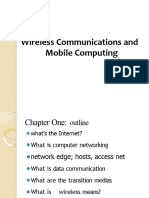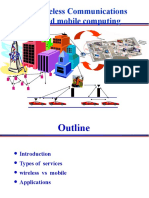Lec#01: Wireless Communication Network: Intro Class
Transcript:
Welcome to the first class of course Wireless Communication Network (WCN)
Mobile vs Wireless
Key Distinctions:
1. Mobile vs Stationary:
o Mobile refers to the ability to move from one place to another, whether within a
room, between rooms, or across countries.
o Stationary means remaining in a fixed location.
2. Wireless vs Wired:
o Wireless signifies the absence of physical connections (like Ethernet cables).
o Wired involves a physical connection to the network via cables.
Technological Evolution:
• Shift to Wireless:
o Over the past 10–15 years, wireless connectivity has become the default.
o Older devices relied on Ethernet ports for wired connections, and wireless was an
optional add-on.
o Today, most devices, including laptops and phones, lack Ethernet ports and rely
solely on wireless networking.
• Shift to Mobility:
o Networking is increasingly designed to support mobility, enabling seamless use
across locations without losing connectivity.
Current Networking Trends:
• Modern networking is primarily wireless and mobile.
• The world is transitioning away from stationary and wired connections, making wireless
mobility the cornerstone of contemporary networking systems.
Wireless and mobile technologies are now integral to networking, reflecting a significant shift
from stationary, wired systems to a dynamic, flexible, and connected world.
1|Page
�Wireless Networking
Key Characteristics of Wireless Networking:
1. No Fixed Infrastructure:
o Wireless networks do not require physical connections like cables or hubs.
o Ad hoc networks allow devices to communicate directly without a base station or
access point, ideal for temporary setups or remote locations.
2. Challenges in Wireless Communication:
o Error-Prone: Wireless signals are susceptible to interference from other devices,
environmental factors, and human activity, leading to frequent errors.
o Frequent Disconnections: High error rates can overwhelm systems, causing
dropped connections.
o Resource Management & Quality of Service (QoS): Maintaining performance and
reliability similar to wired networks is a significant challenge.
o Battery Dependency: Wireless devices rely on battery power, emphasizing energy
efficiency through standards like Bluetooth Low Energy (LE) and Zigbee.
3. Innovative Solutions:
o Energy Harvesting: Future wireless systems aim to eliminate batteries by
harvesting ambient energy from solar rays or wireless signals.
o RFID Technology: Operates without batteries by utilizing energy from external
sources, showcasing potential for battery-less communication.
4. Broadcast Nature & Security Concerns:
o Wireless communication is inherently broadcasted, allowing anyone within range
to potentially listen, raising security concerns.
Additional Considerations:
• Time Synchronization: Wireless systems lack the built-in clock synchronization provided
by wired networks, necessitating alternate solutions.
• Class Participation: Active engagement, such as asking and answering questions, is
encouraged to foster a better understanding of concepts.
2|Page
� Wireless networking provides flexibility and mobility but comes with unique challenges, such
as error management, energy efficiency, and security. Addressing these issues is critical for
advancing wireless technologies and ensuring their reliability in diverse applications.
Mobile Networking
Key Concepts in Mobile Networking
1. Mobility and Location Sensitivity:
o Mobility introduces location issues, as the relevance of information often depends
on the user’s location (e.g., searching for a nearby coffee shop).
o IP was initially designed to be location-sensitive, assigning unique addresses based
on physical location, which causes challenges for mobility.
2. Challenges of Mobility with Traditional IP:
o Traditional IP addressing ties connections to specific locations. Moving a device to
another location breaks the connection, disrupting ongoing activities like file
transfers or streaming.
3. Modern Solutions for Mobility:
o Wireless technologies allow seamless movement across locations while
maintaining uninterrupted communication.
o Users can move between buildings, cities, or even regions while continuing tasks
like watching videos or making calls.
4. Handoff Process:
o Mobility is supported by the handoff mechanism, where devices are continuously
transferred between access points as users move.
o This ensures a smooth transition without losing connectivity or disrupting user
activities.
Here, we focuse on the importance of mobility in modern networking, the challenges posed by
location-sensitive IP design, and how wireless networks address these challenges through
continuous handoff mechanisms
3|Page
�Goal of This Course
Course Overview and Objectives:
1. Comprehensive Scope:
o This course on wireless networking is covering a broad range of topics from
fundamentals to the latest industry trends.
o Students will progress from a beginner level to advanced concepts in one semester.
2. Focus Areas:
o Wireless Communication (Physical Layer): Brief introduction to how data is
transmitted (Layer 1).
o Networking Layers: Emphasis on Media Access Control (Layer 2), Network
Layer (Layer 3), and aspects of Layer 4. Application-level topics are not included.
o Industry and Future Trends: Content is derived from current industry standards
and research, emphasizing recent developments and upcoming innovations.
3. Learning Techniques:
o The course teaches techniques for deep learning and adaptability, preparing
students to handle evolving technologies beyond what is covered in class.
Key Takeaway: This course aims to equip students with a deep understanding of wireless and
mobile networking, emphasizing current and emerging trends. It focuses on developing skills for
continuous learning, essential for staying relevant in the rapidly evolving field of wireless
technologies.
Why Wireless Networking
Importance of Wireless Networking
1. Networking as a Core of Modern Technology:
o Networking is fundamental in computer science and is crucial for the success of
tech giants like Microsoft, Google, Amazon, Facebook, and Apple.
o Wireless networking, in particular, drives innovations in mobile devices, making it
indispensable in today’s tech landscape.
2. Wireless Networking Evolution and Relevance:
o Wi-Fi (Wireless Fidelity): Introduced in 1999, Wi-Fi aimed to provide a wireless
experience equivalent to wired networks.
4|Page
� o Today, most devices—smartphones, tablets, laptops—operate wirelessly, with
wired connections primarily used in data centers and core networks.
o Wireless has become the dominant mode of access for email, browsing, and other
daily activities.
3. Economic Impact of Wireless Networks:
o Telecommunications companies like AT&T, Verizon, and T-Mobile have shifted
their revenue focus to wireless services, as traditional landline services are obsolete.
o Wireless technologies like 4G and 5G provide high-speed connectivity (up to 1
Gbps with 5G), reducing the need for wired connections.
4. Emerging Applications and Innovations:
o 5G Networks: Offering higher speeds and enabling applications like connected
vehicles and IoT.
o Vehicular Networking: Cars will communicate with each other for enhanced safety
and efficiency.
o Cognitive Networking: Addresses the issue of limited spectrum by enabling
dynamic sharing of unused spectrum, ensuring efficient utilization.
5. Challenges in Wireless Networking:
o Spectrum licensing and underutilization of allocated frequencies have historically
caused inefficiencies.
o Cognitive networking seeks to overcome this by allowing others to use idle
spectrum, optimizing resource usage.
Wireless networking is critical for modern technology, enabling innovation, efficiency, and
economic growth. With advancements like 5G, vehicular networking, and cognitive systems, it
continues to shape the future of communication and connectivity.
Mobile Internet
Key Milestones and Impact of Mobile Internet
1. Birth of Modern Mobile Internet:
o June 29, 2007, marked the launch of the iPhone by Apple, revolutionizing mobile
internet usage.
5|Page
� o Unlike earlier "smartphones," the iPhone offered full computer functionality and
introduced an open app market, enabling developers of all scales to create and sell
apps.
2. Transformation of Connectivity:
o The introduction of the app market democratized software development and
fueled rapid innovation.
o Smartphones have become essential, driving reliance on mobile websites and apps
across all industries.
3. Exponential Growth in Mobile Traffic:
o In 2014, global mobile traffic reached 2.5 × 10¹⁸ bytes per month, 30 times the
total global wired internet traffic in 2000.
o Mobile video accounts for over 55% of mobile traffic, reflecting the rise of
streaming services like Netflix and Amazon Video.
4. Technological Advancements:
o Early challenges like slow speeds and buffering issues have been overcome,
enabling smooth video streaming and real-time communication.
o Mobile video now delivers TV-like quality, further driving its popularity.
5. Challenges in Mobile Internet:
o Issues like errors, disconnections, limited bandwidth, and range persist.
o The course aims to address these challenges and explore solutions to ensure
robust mobile connectivity.
6. References and Resources:
o The lecture materials are recent and include clickable references for deeper
exploration of key concepts.
The mobile internet has grown exponentially since the iPhone's launch in 2007, reshaping how
people connect, work, and consume content. Despite challenges, advancements in technology
continue to improve the quality and reliability of mobile connectivity, making it indispensable in
today's world.
6|Page
�Internet of Things
Key Concepts of IoT
1. Definition of "Smart" Devices:
o Devices are considered "smart" when they are connected to the internet, enabling
wireless functionality.
o Examples include smartwatches, TVs, cars, homes, industries, cities, and more.
2. Role of Wireless Connectivity:
o IoT heavily relies on wireless technology to function efficiently.
o Wired connections are impractical for many IoT applications, such as smart cars,
watches, or portable devices.
3. Importance of Mobility and Wireless:
o Mobility and wireless networking are critical skills for professionals in IoT-
related fields.
o These concepts ensure seamless connectivity across diverse applications, from
homes to industries.
IoT is transforming every aspect of life, making wireless connectivity essential. The course will
focus on foundational wireless communication, networking protocols, and IoT-specific
challenges, preparing students for IoT's dynamic and evolving landscape.
7|Page































































































